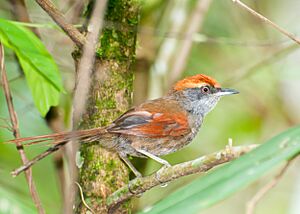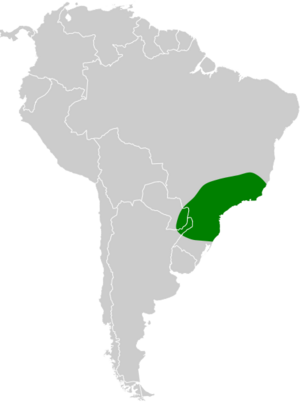Rufous-capped spinetail facts for kids
Quick facts for kids Rufous-capped spinetail |
|
|---|---|
 |
|
| At Registro, São Paulo, Brazil | |
| Conservation status | |
| Scientific classification | |
| Genus: |
Synallaxis
|
| Species: |
ruficapilla
|
 |
|
The rufous-capped spinetail (scientific name: Synallaxis ruficapilla) is a small bird. It belongs to the ovenbird family, called Furnariidae. These birds are known for building unique nests that sometimes look like ovens! You can find the rufous-capped spinetail in parts of Argentina, Brazil, and Paraguay.
Contents
About the Rufous-capped Spinetail
The rufous-capped spinetail is a medium-sized bird, about 13 to 17 centimeters (5 to 7 inches) long. It weighs about 12 to 16 grams (0.4 to 0.6 ounces). Both male and female birds look the same.
What Does It Look Like?
Adult spinetails have a wide, light-colored stripe above their eyes, called a supercilium. The area around their eyes and ears is dark brownish-gray. Their head and the back of their neck are a bright orange-red color. The rest of their back and rump are a reddish-brown.
Their wings are mostly chestnut-brown. Their tail is also chestnut-colored and gets narrower towards the end, with pointed feather tips. The chin has a tiny light brown spot. The rest of their chin and throat are whitish with faint gray lines. Their upper chest is grayish, and the rest of their belly is a lighter brownish color.
Their eyes are reddish-brown. The upper part of their beak (maxilla) is black, and the lower part (mandible) is gray with a dark tip. Their legs and feet are greenish-gray.
Young Spinetails
Young spinetails have a duller head color than adults. They have little to no chin spot. Their underparts might have a yellowish or brownish tint.
Where Do They Live?
The rufous-capped spinetail lives in Brazil, Paraguay, and Argentina. In Brazil, they are found from southern Goiás east to Espírito Santo and south into northern Rio Grande do Sul. In Paraguay, they live in the far eastern parts. In Argentina, they are found in the Misiones and Corrientes provinces.
Their Home Environment
These birds live in the undergrowth and edges of many different forest types. This includes mountain forests and lowland evergreen forests, both old-growth and new-growth. They especially like areas with Chusquea bamboo plants. You can find them from near sea level up to about 1,400 meters (4,600 feet) high.
Behavior and Life Cycle
Movement and Migration
The rufous-capped spinetail stays in the same area all year round. It does not migrate.
What Do They Eat?
Scientists don't know a lot about what the rufous-capped spinetail eats or how it finds food. They believe it mostly eats small insects and other arthropods. These birds usually search for food in pairs. They often join groups of different bird species that are feeding together. They typically look for food in the lower parts of the forest, but sometimes they will go up into the middle levels or even search on the ground. They are thought to catch their prey by picking it off leaves and small branches.
Reproduction and Nests
The rufous-capped spinetail builds its nest and raises its young during the spring and summer in the Southern Hemisphere. They are thought to stay with one partner. Their nest is a large, messy pile of thorny sticks. It has a tube-like entrance that slants downwards. They usually place their nests in thick plants, about 1 to 2.5 meters (3 to 8 feet) above the ground.
A female spinetail usually lays two to three eggs. We don't know how long the eggs take to hatch, how long it takes for the young birds to leave the nest, or many details about how the parents care for their young.
Bird Calls and Songs
The song of the rufous-capped spinetail has been described in different ways. Some say it sounds like a fast, nasal "di-di-di-réét." Others describe it as "tdrrrWit" or a quiet, strong "drrrrrt wee." Their call is a special low-pitched trill, like "tshrrr," or a dry rattling sound, like "trrrrruh."
Conservation Status
The IUCN (International Union for Conservation of Nature) has listed the rufous-capped spinetail as a species of "Least Concern." This means they are not currently in danger of disappearing. They live across a large area, and while their exact population size isn't known, it is believed to be stable. No immediate threats to their survival have been found. Even though they are not very well-known, they are considered to be uncommon to common in their habitat. They can be found in several protected areas, which helps keep them safe.


